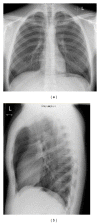Pneumomediastinum in blunt chest trauma: a case report and review of the literature
- PMID: 25114811
- PMCID: PMC4119635
- DOI: 10.1155/2014/685381
Pneumomediastinum in blunt chest trauma: a case report and review of the literature
Abstract
Blunt trauma is the most common mechanism of injury in patients with pneumomediastinum and may occur in up to 10% of patients with severe blunt thoracic and cervical trauma. In this case report we present a 24-year-old man with pneumomediastinum due to blunt chest trauma after jumping from a bridge into a river. He complained of persistent retrosternal pain with exacerbation during deep inspiration. Physical examination showed only a slight tenderness of the sternum and the extended Focused Assessment with Sonography for Trauma (e-FAST) was normal. Pneumomediastinum was suspected by chest X-ray and confirmed by computed tomography, which showed a lung contusion as probable cause of the pneumomediastinum due to the "Mackling effect." Sonographic findings consistent with pneumomediastinum, like the "air gap" sign, are helpful for quick bedside diagnosis, but the diagnostic criteria are not yet as well established as for pneumothorax. This present case shows that despite minimal findings in physical examination and a normal e-FAST a pneumomediastinum is still possible in a patient with chest pain after blunt chest trauma. Therefore, pneumomediastinum should always be considered to prevent missing major aerodigestive injuries, which can be associated with a high mortality rate.
Figures



Similar articles
-
Pneumomediastinum and pneumopericardium following blunt thoracic trauma: much ado about nothing?Eur J Trauma Emerg Surg. 2019 Oct;45(5):927-931. doi: 10.1007/s00068-018-0960-5. Epub 2018 Apr 23. Eur J Trauma Emerg Surg. 2019. PMID: 29687275
-
Dyspnoea and chest pain as the presenting symptoms of pneumomediastinum: two cases and a review of the literature.Cardiovasc J Afr. 2015 Nov-Dec;26(6):e1-4. doi: 10.5830/CVJA-2015-035. Epub 2015 Oct 8. Cardiovasc J Afr. 2015. PMID: 26498134 Free PMC article. Review.
-
Occult pneumomediastinum in blunt chest trauma: clinical significance.Injury. 2010 Jan;41(1):40-3. doi: 10.1016/j.injury.2009.06.161. Injury. 2010. PMID: 19604507
-
Laryngeal fracture due to blunt trauma presenting with pneumothorax and pneumomediastinum.ORL J Otorhinolaryngol Relat Spec. 2011;73(5):246-8. doi: 10.1159/000329566. Epub 2011 Aug 5. ORL J Otorhinolaryngol Relat Spec. 2011. PMID: 21822030
-
Blunt trauma related chest wall and pulmonary injuries: An overview.Chin J Traumatol. 2020 Jun;23(3):125-138. doi: 10.1016/j.cjtee.2020.04.003. Epub 2020 Apr 20. Chin J Traumatol. 2020. PMID: 32417043 Free PMC article. Review.
Cited by
-
Tension Pneumomediastinum and Coronary Artery Thrombosis Following a Motorcycle Accident: A Case Report.Clin Pract Cases Emerg Med. 2023 May;7(2):97-100. doi: 10.5811/cpcem.1410. Clin Pract Cases Emerg Med. 2023. PMID: 37285493 Free PMC article.
-
Risk factors for mediastinitis and mortality in pneumomediastinum.J Cardiovasc Thorac Res. 2022;14(1):42-46. doi: 10.34172/jcvtr.2022.09. Epub 2022 Mar 15. J Cardiovasc Thorac Res. 2022. PMID: 35620749 Free PMC article.
-
Pneumomediastinum and pneumopericardium following blunt thoracic trauma: much ado about nothing?Eur J Trauma Emerg Surg. 2019 Oct;45(5):927-931. doi: 10.1007/s00068-018-0960-5. Epub 2018 Apr 23. Eur J Trauma Emerg Surg. 2019. PMID: 29687275
-
Dyspnoea and chest pain as the presenting symptoms of pneumomediastinum: two cases and a review of the literature.Cardiovasc J Afr. 2015 Nov-Dec;26(6):e1-4. doi: 10.5830/CVJA-2015-035. Epub 2015 Oct 8. Cardiovasc J Afr. 2015. PMID: 26498134 Free PMC article. Review.
-
Pulmonary contusions after blunt chest trauma: clinical significance and evaluation of patient management.Eur J Trauma Emerg Surg. 2018 Oct;44(5):773-777. doi: 10.1007/s00068-017-0876-5. Epub 2017 Nov 22. Eur J Trauma Emerg Surg. 2018. PMID: 29167928
References
-
- Macklin C. Transport of air along sheaths of pulmonic blood vessels from alveoli to mediastinum: clinical implication. Archives of Internal Medicine. 1939;64:913–926.
-
- Wintermark M, Schnyder P. The Macklin effect: a frequent etiology for pneumomediastinum in severe blunt chest trauma. Chest. 2001;120(2):543–547. - PubMed
-
- Banki F, Estrera AL, Harrison RG, et al. Pneumomediastinum: etiology and a guide to diagnosis and treatment. The American Journal of Surgery. 2013;206(6):1001–1006. - PubMed
-
- Laennec R. A Treatise on Diseases of the Chest and on Mediate Auscultation. New York, NY, USA: Samuel Wood & Sons; 1830.
LinkOut - more resources
Full Text Sources
Other Literature Sources
Miscellaneous

